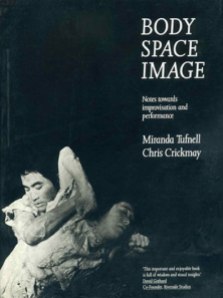Physical Graffiti
May 11, 2019
Art Therapy and Physical Graffiti
Art Therapy/School of Visual Arts (New York) + Art Therapy/Crawford College of Art and Design (Cork)
Art therapy should be relevant to life where it happens, an intervening event and a beacon. Art from the materials of life, and within environments of encounter. Being moved to cultivate surroundings that are both disruptive and restorative and as an antidote to disillusionment and indifference. This is a workshop about art therapy getting out more. Extending repertoire. Art therapy can generate habitats where people spend time together. The outdoor studio is a place where anything can happen.
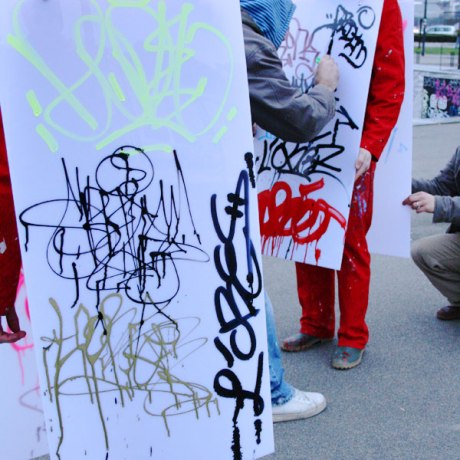
Photos: David Renault and Mathieu Tremblin, Human Hall of Fame, 2010, Nantes France, Walking Graffiti – Sandwich Boards for Collective Art Making
Workshop Description
- We will work within an outdoor studio that is both a place for nature, people and social actions.
- Collaborative installations will be made through the selection of locations that develop a scene and a situation of encounters with nature based materials and each other.
- Physicality will be investigated in relation to collaborative (small group) designed installations, which will be the basis for exploring and depicting space through movement.
- Graffiti is about making a public statement. The art will be a small group installation that becomes an environment or composition of dissent, rather than the painted message on the wall. Our graffiti will be an inhabited space that composes a message, a territory, and a means by which to make art out-in-the-open.
- As graffiti relates to writing (the origin of the word also means to scratch the surface) each person will write about their own forms of protest and their quest to make their mark within the world-at-large. Each spoken word presentation will combine a collection of voices from each group of installation makers.
- Participants will also translate their words into a movement motif, lines of writing developing sequence of movement that extends each person through gesture and action into pubic life.
- The potential role of choreography within art therapy will also be discussed with reflections on this topic presented for the development of movement studies.
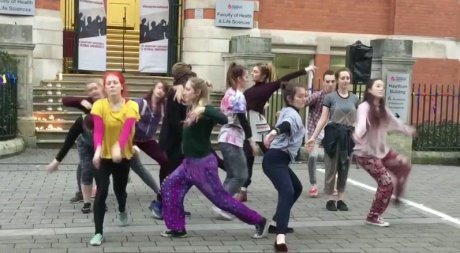
Photo: Forward Motion Protest, a 24 hour vigil supporting the rights of refugees in the UK, De Montfort University, Leicestershire, UK
Materials to Bring Along
- Outdoor clothing for all weather and walking shoes
- Water and snacks
- A sketch book
- Drawing and writing materials
- A fully charged phone for taking photographs
- A small blanket (or throw) to sit or lay down on. (Pennys in Cork should sell these for 5.00 Euros). This is optional.
Agnes Yoshii, Minimal Dance Unit, Japan
https://www.instagram.com/aguyoshi/?hl=en
Preparation
- View social movements and protests on the internet and observe physical signs of dissent. How does activism move people?
- What are the messages of protest that also relate to your own forms of activism, or desire to be part of a demonstration that seeks social change.
- Record your impressions of the above through sketches and photographs and write down the messages of protest that move you. These movement sketches and notes regarding protest messages will be used in our workshop.

Photo: A street dance to protest an arms fair being held in London, 2017.
Social movements and activism can disrupt, protest and interrupt conventions of daily life. Physical graffiti is an enactment that disturbs complacency and codes of behaviour. Outside, making a statement, and erupting within everyday places—graffiti is making an impression upon a physical location. Graffiti is an artistic enterprise, claiming territory and making one’s mark upon the scenes where people live out their lives.
Movement is integral to art production, the making of place and composing identity in relation to social and political environments. Art therapy involves the art of movement, and can contribute to an understanding of aesthetics and politics. An examination of borders is part of art therapy—drawing lines demarcating personal distinctions and demonstrating the crossing-over into new areas of discernment. Art therapy can also inform protests that are both personal and socially informed, which also cross over social borders.

Photo: Message found in Belfast, Northern Ireland
Art therapy marks out routes of passage within a designated space, it can design sequences of movement and denote a body in motion. Compositions on the move, explorations of environment, and art influenced by context that simultaneously re-imagines space according to somatic knowledge.
The art therapy studio can include the world-at-large.
Art therapy contributes to civic dialogue – art therapy asking complicated questions about expression and representation in civil society.

Art Therapy for Social Justice: Radical Intersections (2019) edited by Savneet K. Talwar
“An underlying assumption equates social justice to access, and to fair and just treatment for all. Social justice in the mental health field (art therapy, counselling, or psychology), therefore, translates into understanding how clients are positioned in society and if they ave equal and fair less to resources and benefits. A social justice paradigm broadens the scope of practice to incorporate a critical perspective on the ways subjectivity is socially and politically constructed, and the ways history and language produce representations of non-normative identities” (Savneet Talwar, 2019, p. 11)
“An intersectional analysis of race, class, gender and sexuality, and disability inevitably leads to memory, emotions, and the body to convey the embodiment of culture” (Savneet Talwar, 2019, pg. 38)
“An art therapy practice informed by intersectionality explore the embodiment of lived experience from personal, social and political perspectives” (Savneet Talwar, 2019, p. 40)
“History always weighs on the body and its materiality. Foucault..argues that discipline creates docile bodies, which are ideal for achieving the goal of citizenship, reached though cooperation and the desire to fit within society. Good citizenship relies on internalising disciplinary powers in order to self regulate the body…Intersectionality as a methodology asks that we investigate the visible and invisible systems of power to allow for a deeper analysis of social categories of difference and the disciplinary powers that have sanctioned shame, violence and trauma, thus stigmatising the performance of non-normative bodies. The interaction between the personal and social is a political one” (Savneet Talwar, 2019, pp. 41-41)
“Public Practice Art Therapy: Enabling Spaces Across North America” by Janis Timm-Bottos (Canadian Art Therapy Association Journal, 2017, Volume 30)
- “Art is a voice that refuses to be silenced”
- “Art therapists have an important leadership role as neighbourhoods and institutions are becoming receptive sites…that welcome everyone to creatively embrace the complexities of our world” (Janis Timm-Bottos, 2017)
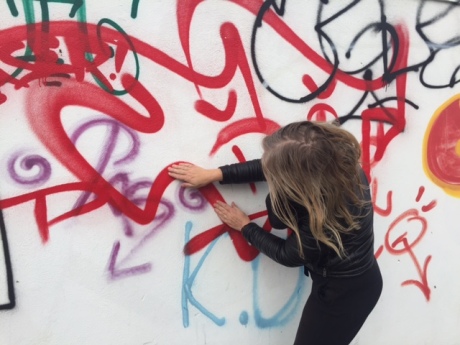
Photos: (Top) Art Therapy Trainees, Crawford College of Art and Design (Bottom) Moving with Graffiti alongside the Grand Canal, Dublin
Social Choreography, Constructed Situations, Tino Sehgal
German artist Tino Sehgal choreographs experiences, he constructs situations in public locations that catch people off guard, beginning conversations and contact between strangers. The orientation of his performative art form is influenced by his background as a dancer. The materials of the dance between strangers is physical presence, happenstance and discussions related to human experience and philosophy. People come together in unplanned encounters that stimulate contact through a sense of being together within a particular place and time. Participants are stopped in their paths, in order to meet within an enhanced level of human connection. Names are not important, but sharing opinions, beliefs and experiences entangle the conversation with different approaches to meaning. Sehgal’s work is not theatrical; it is a choreography with choices. It is about movement, pathways, interactions and encounters. He implicates habitual movements within public thoroughfares with surprise meetings. Somehow awakening the body, while awakening the mind, and inviting new ways of approaching everyday worlds.
Michael Klein, The Everyday Social Choreographer
- “Choreography is the act of framing relations between bodies as a way of seeing the world”
- “Choreography is not to constrain movement into a set pattern, it is to provide a cradle for movement to find its own patterns.”
- “We are inscribed with the ability to bring about changes; to create conducive conditions for things to happen, for patterning and re-patterning. Doing so is the act of the everyday choreographer” (Michael Klein, http://www.michaelklien.com)
Choreographic Elements to be explored in our social movements inspired by Rudolf Laban:
- Direct and Indirect Movements
- Slow Paced and Sudden Movements
- Light and Strong Movements
- Different Levels of Movement
- Moving in the the spherical space around the body
- Stillness
- Turning
- Gesturing
- Travel
Link for the Book of Recommendations: Choreography as an Aesthetics of Change:
Dance represents flexibility and flux, a deviation from language and fixed terms of reference. The body moves desire in a visible and amplified way. The dancer’s body invites us to imagine new positions and new courses of action. The dancer and witness are immersed together in a collaborative relationship. They move each other along and disseminate the nature of what is ephemeral. Ultimately this is about the unfixed nature of meaning and representation. The body in motion is an essential part of art therapy, and it is the primary material of art making. Space can be sculpted and animated with effort qualities that choreograph intention and direct action. To observe the physicality of art therapy is to pay close attention to the way the body moves within a given environment. Somatic reckoning permeates art therapy space, it is an inherent element of creative production.
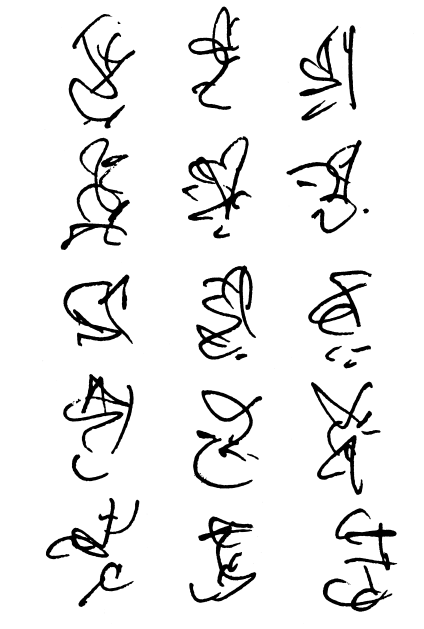
Nancy Stark Smith, Choreography Hieroglyphs
Activating art therapy within the thresholds of physical experience is letting go of art therapy’s propensity towards order and containment. The dynamics of change are an essential aesthetic component of art therapy practice, and reside within the illustrations of movement as they manifest between therapeutic participants and art media. Art therapy evokes an ecology of circumstances, situations within which to explore movement inwards and outwards into the exteriors of personal and shared space. It is this combination, and the urge to process experience, that makes art therapy a somatic performance that marks out mobile forces of representation. The body is the living artwork, and imprints materials with surges of evocation that might be marks on paper, but equally can be made into sculptural forms that inhabit the art therapy studio. Ultimately, this instinctive choreography may result in redesigning the art therapy space through movement patterns that mark out paths of what Michael Klien terms “ungovernable moments.”
Chris Sollars, Subverting Pubic Space through Found Object Sculptures
“There is a satisfaction that comes from this unexpected audience that have to deal with these objects in space—they can avoid, destroy, or yell at me the maker. It’s a different viewing experience than art spaces with predetermined rules. My work subverts public space through interventions and performance. The results are documented using photographs, sculpture, and video that are integrated into mixed-media installations/sculptural residue. These sculptures bridge multi-disciplines that utilise different methods of display and combine into one. My work is temporal in nature and its duration can be seconds, minutes, hours, days or years. Two viewing opportunities exist for my work, first as a witness to the event itself in public and second as a viewer watching the mediated documentation of the event. This documentation is gathered and composed as an installation in order to physically position the viewer in an active role. My process is physical and conceptual as I juxtapose dissimilar elements, objects, or materials to create an unexpected form that is often comedic” (Source: Chris Sollars website, http://www.667shotwell.com)
Robin Rhodes: Wall Drawings
“Robin Rhodes explores Street art, minimalism, social practice, urban design, explorations of play, reenactment, and gesture that manifest as performance and wall drawings…Rhodes’ performances are based partially on initiation rituals that were part of his life as a teenager in high school in South Africa” (Source: http://www.artspace.com)
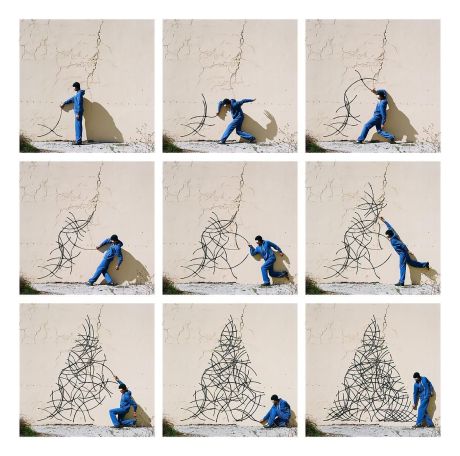 Robin Rhodes, X (2010)
Robin Rhodes, X (2010)
“Take an image, let it hang in the mind, let the sensation of the thought dissolve through the body. Let the movement inside the body…move outside. Allow the sensations their own time and expression…waiting for a space between the thoughts, an unlocking of the parts of the body – a gap into which something new can emerge” (Miranda Tufnell and Chris Crickmay, Body, Space, Image: Notes Towards Improvisation and Performance).
“Where you are when you don’t know where you are is one of the most precious spots offered by improvisation. It is a place from which more directions are possible than anywhere else. I call this place the gap. The more I improvise, the more I’m convinced that it is through the medium of these gaps – this momentary suspension of reference point – that comes the unexpected and much sought after ‘original’ material. It’s ‘original’ because its origin is the current moment and because it come from outside our usual frame of reference” (Nancy Stark Smith quoted in Miranda Tufnell and Chris Crickmay, Body, Space, Image: Notes Towards Improvisation and Peformance).
“Each person is at once responsive to others and independent of them, ready to be changed by, but not absorbed into another person’s activity. The skill lies in being able to include what another person is doing, while not losing one’s own momentum of thought. Each person must become an ingredient in the mixing and making of a piece. There is no place for manners or mannerisms. Social conventions, routine habits of polite or impolite daily life, suppress the sensory and imaginative world from which this work begins” (Simone Forti quoted in Miranda Tufnell and Chris Crickmay, Body, Space, Image: Notes Towards Improvisation and Performance).
Willi Dorner: Bodies in Urban Spaces
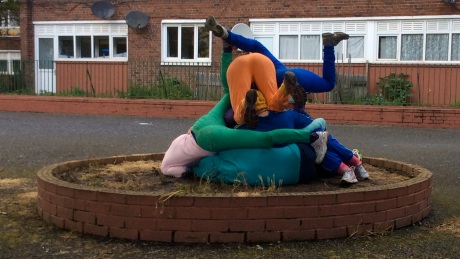
“Bodies in Urban Spaces is a temporary intervention in diversified urban architectonical environments. The intention of bodies in urban spaces is to point out the urban functional structure and to uncover the restricted movement possibilities and behaviour as well as rules and limitations. By placing the bodies in selected spots the interventions provoke a thinking process and produce irritation. Passers by, residents and audience are motivated and prompted to reflect their urban surrounding and there own movement behaviour and habits. Bodies in Urban Spaces invites the residents to walk their own city thus establishing a stronger relationship to their neighbourhood, district and town. The interventions are temporary without leaving any traces behind, but imprints in the eye-witnesses a memory”. (Willi Dorner, http://www.ciewdorner.at)
